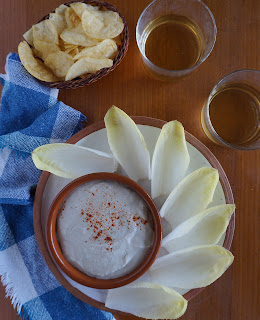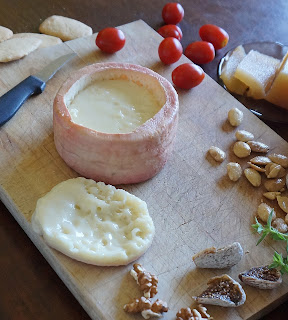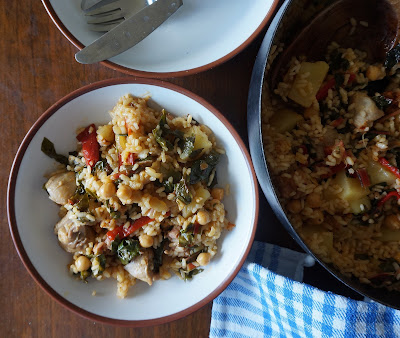 |
| Cheese board with Cabrales, a blue-veined cheese from Asturias. With bubbly cider, white wine and dry Sherry. |
I wrote last week about an unusual cheese, Torta del Casar from Extremadura. I’ve got another cheese up my sleeve, so to speak, also purchased at the Feria Nacional de Queso in Trujillo. This one, Cabrales, comes from northern, green Spain, the Principado de Asturias.
Cabrales is the name of the region where the cheese is made, specified on the label as a protected denomination of origin. It can officially be made with cow’s milk or with a mixture of cow, goat and sheep milk. The cheese is matured in mountain caves where the Penicillium mold causes it to form blue-green veins throughout. Its aroma is intense, the texture is creamy, buttery. The flavor of Cabrales is salty, mildly acidic, somewhat piquant.
Cabrales cheese can be served as an appetizer or dessert cheese accompanied by bread, crackers or toasts and fresh or dried fruits. It also lends itself well to combining with other ingredients for sauces or for embellishing variations on pizza or quiche.
 |
| Creamy Cabrales sauce tops a burger with grilled mushrooms and sautéed piquillo peppers. |
 |
| Cabrales sauce makes an interesting change for pasta with broccoli. |
 |
| Cabrales whipped with yogurt for a tasty dip or dressing. |
 |
| Slivers of Cabrales top a salad with pears, endive, and almonds. Serve the dressing separatley. |
Burgers with Cabrales Blue Cheese Sauce
Burguer con Salsa Cabrales
Vegetarians can forgo the meat burger and pile the grilled mushrooms on buns with the piquillos and Cabrales sauce.
Toasted buns
Grilled burgers
Oyster mushrooms grilled with garlic
Sautéd piquillo peppers and onions with red pepper flakes
Cabrales blue cheese sauce (recipe below)
Place mushrooms on buns and top with the sautéd piquillo peppers. Place a burger on the stack and spoon warm Cabrales sauce on the meat. (The burgers pictured are made with ground chicken thighs.)
Fettuccine with Broccoli and Cabrales Blue Cheese Sauce
Pasta con Brócoli y Salsa Cabrales
Make this vegetarian by omitting the bacon.
Serves 4.
8 ounces fettuccine noodles
Salt
2 cups broccoli florets
3 tablespoons olive oil
½ cup diced bacon
2 cloves sliced garlic
1 cup Cabrales blue cheese sauce (recipe follows)
Grating of fresh nutmeg
Freshly ground black pepper
Chopped chives
Cook the noodles in boiling salted water according to package directions. Reserve 1 cup of the pasta cooking water. Drain the pasta.
Blanch the broccoli florets in boiling water 1 minute. Drain and reserve.
Heat the oil in a large skillet with the bacon and garlic. When garlic starts to turn golden, add the broccoli and fry a few minutes. Stir in the Cabrales sauce. Season with nutmeg and pepper. Add salt to taste. Add the reserved pasta cooking water and heat. Add the cooked noodles and mix them well with the sauce. Serve garnished with chopped chives.
Cabrales Blue Cheese Sauce
Salsa de Queso Cabrales
Cabrales sauce is classic with entrecôte steak, but it’s also good with hamburgers, baked potato, or pasta. The cheese cooks with cream, making it quite rich and also tempering the greenish color of the mashed cheese. Season the sauce with any favorite herbs. Salt may not be needed at all. For a very thick sauce, let it cook slowly until reduced by half.
2 tablespoons olive oil
2 tablespoons finely chopped shallots
6 ounces Cabrales blue cheese (about 1 cup)
½ cup cider, white wine or Sherry
Pinch of rosemary or thyme
Freshly ground black pepper
1 cup cream
Heat the oil on medium and poach the shallots until softened, 5 minutes. Do not let them brown. Break up the cheese and mash it in the pan with the shallots. Add the cider and cook, stirring, until the cheese is melted. Add the rosemary, pepper, and cream and cook on medium until the sauce is reduced by almost half, 15 to 20 minutes.
Serve the sauce hot, warm, or room temperature. Store it covered and chilled.
Salad with Pears, Endive, and Cabrales Blue Cheese
Ensalada de Pera con Endibia y Cabrales
Serves 4
2 ounces Cabrales cheese
2 ripe, firm pears
3-4 Belgian endives
1 tablespoon Sherry vinegar
4 tablespoons extra virgin olive oil
½ cup slivered red bell pepper
4 tablespoons toasted hazelnuts or almonds
Chopped chives to garnish
Cabrales Blue Cheese Dressing to accompany (recipe follows)
While cheese is still cold and firm, cut it into shards and let them come to room temperature.
Peel the pears, cut them in half, and remove cores. Slice them lengthwise. Chop or shred the endive leaves and divide them between 4 salad plates. Arrange the sliced pears on top. Scatter the red pepper and hazelnuts over the salads.
Whisk together the vinegar and oil and drizzle them over the salads. Divide the shards of Cabrales on top. Garnish with chives. Serve the salads accompanied by the Cabrales Blue Cheese dressing.
Cabrales Blue Cheese Dressing
Aliño con Cabrales
This non-cooked sauce makes a great dip with chips or vegetable dippers. Use it as a salad dressing as well.
¼ cup chopped scallions
½ cup Greek yogurt
4 ounces Cabrales cheese
1 tablespoon dry Sherry
1/8 teaspoon cumin seeds
1/8 pimentón picante de la Vera (smoked hot paprika) or cayenne
Combine all the ingredients in a mini-processor. Process until smooth.
What to drink with Cabrales cheese? I asked Gerry Dawes, an expert on Spanish wines who knows his way around the cheeses of Asturia.
"In Asturias, they drink cider, which goes very well with Cabrales. White wines with good acidity to cut through the creaminess, richness and mold of Cabrales would be Albariño, but especially wines from Ribeiro. Just like Sauternes with Roquefort, sweet wines are great. Late-harvest Moscateles from Navarra, sweet Malvasias from the Canarias, Torres San Valentin semi-dulce from Penedès. Also rosados from Navarra, which have good acidity and, of course, Cava, even the semi-dulce, though Brut Nature Cava will also be a good counterpoint. The great sherries, from Manzanilla to Tio Pepe to the Palo Cortados and Olorosos. I would also drink the excellent cream Sherries and Moscatel de Chipiona with Cabrales.” Thanks, Gerry, that’s a wide choice. And not a single red wine!
(Photo:Gerry Dawes presenting Asturian cheeses at Alimentaria, Barcelona, 2010.)
Gerry is the author of Sunset in a Glass, a collection of stories about life, food, wine and people in Spain.
Cabrales has its own cheese festival, the Certamen del Queso de Cabrales, in Arenas de Cabrales, Asturias, the last Sunday of August.
More about Spanish cheeses:






















